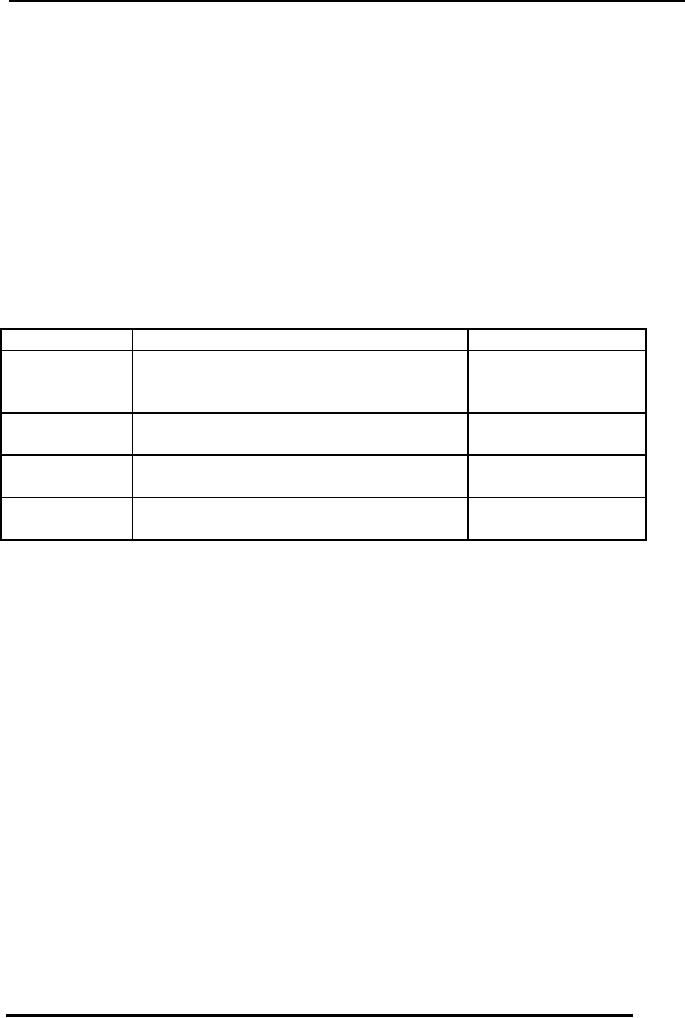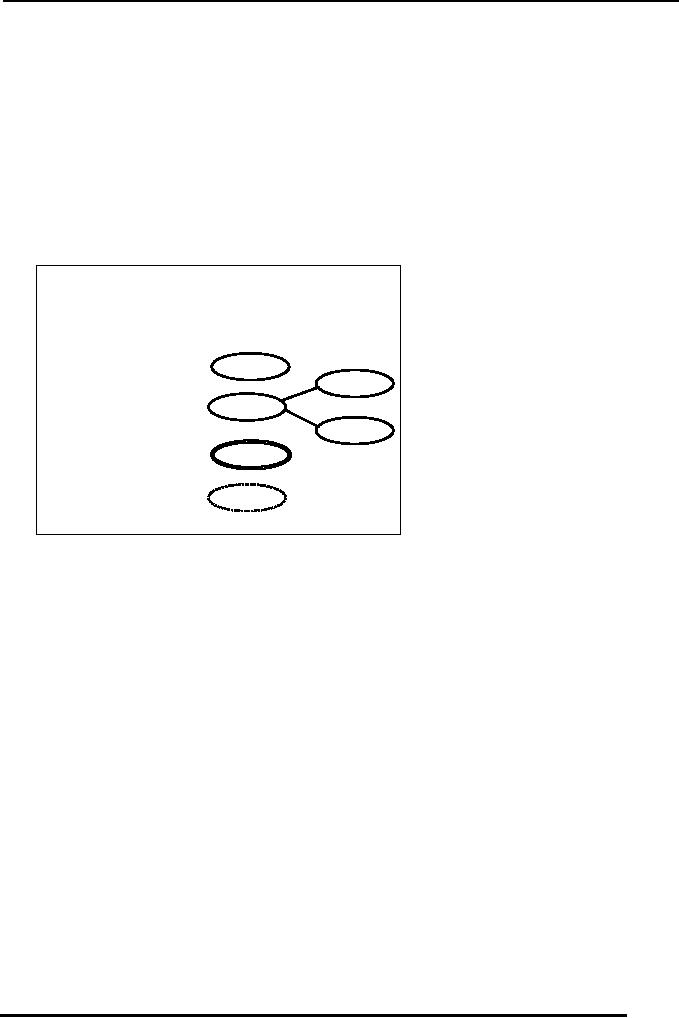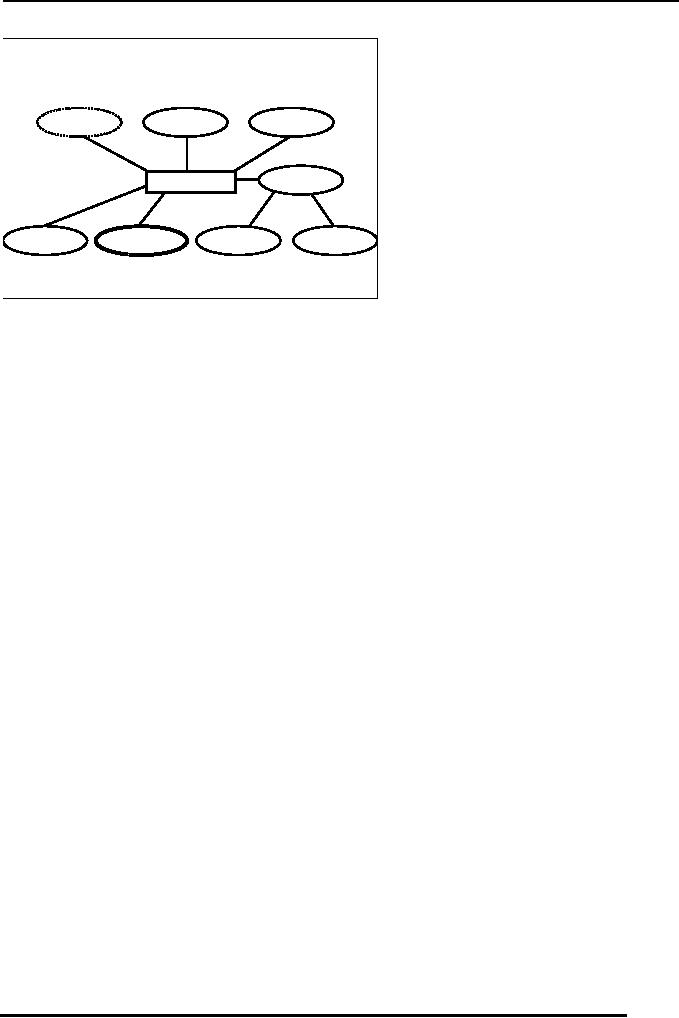 |
Entity-Relationship Data Model, Classification of entity types, Attributes |
| << Data Flow Diagram, Data Dictionary, Database Design, Data Model |
| Attributes, The Keys >> |

Database
Management System
(CS403)
VU
Lecture No.
07
Reading
Material
"Database
Systems Principles, Design and
Implementation"
Section:
5.2 5.3
written
by Catherine Ricardo, Maxwell
Macmillan.
Hoffer
Page: 85
- 95
Overview of
Lecture
Entity
o
Different
types of Entities
o
Attribute
and its different
types
o
In the
previous lecture we discussed
the importance and need of
data models.
o
From
this lecture we are going to
start detailed discussion on a
data model, which
is the
entity relationship data
model also known as E-R
data model.
Entity-Relationship
Data Model
It is a
semantic data model that is
used for the graphical
representation of the
conceptual
database
design. We have discussed in
the previous lecture that
semantic data models
provide
more constructs that is why a
database design in a semantic data
model can
contain/represent
more details. With a
semantic data model, it
becomes easier to design
the
database, at the first place, and
secondly it is easier to understand
later. We also know
that
conceptual database is our
first comprehensive design. It is
independent of any
particular
implementation of the database,
that is, the conceptual
database design
expressed
in E-R data model can be
implemented using any DBMS.
For that we will have
to
transform the conceptual
database design from E-R
data model to the data
model of the
particular
DBMS. There is no DBMS based
on the E-R data model, so we
have to
transform
the conceptual database design
anyway.
A
question arises from the
discussion in the previous paragraph, can
we avoid this
transformation
process by designing our
database directly using the
data model of our
selected
DBMS. The answer is,
yes we can but we do not do
it, because most
commercial
DBMS
are based on the
record-based data models,
like Hierarchical, Network
or
Relational.
These data models do not
provide too much constructs,
so a database design
70

Database
Management System
(CS403)
VU
in these
data models is not so
expressive. Conceptual database design
acts as a reference
for
many different purposes. Developing it in
a semantic data model makes
it much more
expressive
and easier to understand, that is why we
first develop our conceptual
database
design in
E-R data model and then
later transform it into the
data model of our
DBMS.
Constructs
in E-R Data Model
The
E-R data model supports
following major
constructs:
· Entity
· Attribute
· Relationship
We are
going to discuss each one of
them in detail.
The
Entity
Entity is
basic building block of the
E-R data model. The
term entity is used in
three
different
meanings or for three
different terms and that
are:
· Entity
type
· Entity
instance
· Entity
set
In this
course we will be using the precise
term most of the time.
However after knowing
the
meanings of these three
terms it will not be difficult to
judge from the context
which
particular
meaning the term entity is
being used in.
Entity
Type
The
entity type can be defined as a
name/label assigned to items/objects
that exist in an
environment
and that have similar
properties. It could be person, place,
event or even
concept,
that is, an entity type can
be defined for physical as
well as not-physical
things.
An entity
type is distinguishable from
other entity types on the
basis of properties and
the
same
thing provides the basis
for the identification of an
entity type. We analyze
the
things
existing in any environment or place. We
can identify or associate
certain
properties
with each of the existing in
that environment. Now the
things that have
common or
similar properties are candidates of
belonging to same group, if we
assign a
name to
that group then we say
that we have identified an
entity type.
Generally,
the entity types and their
distinguishing properties are established
by nature,
by very
existence of the things. For
example, a bulb is an electric accessory,
a cricket bat
is a sports
item, a computer is an electronic
device, a shirt is a clothing
item etc. So
identification
of entity types is guided by
very nature of the things
and then items having
properties
associated with an entity
type are considered to be belonging to
that entity type
or instances of
that entity type. However,
many times the grouping of
things in an
environment
is dictated by the specific
interest of the organization or
system that may
supersede
the natural classification of
entity types. For example,
in an organization, entity
71

Database
Management System
(CS403)
VU
types
may be identified as donated items,
purchased items, manufactured items;
then the
items of
varying nature may belong to
these entity types, like
air conditioners, tables,
frying
pan, shoes, car; all
these items are quite
different from each other by
their
respective
nature, still they may be
considered the instances of the same
entity type since
they
are all donated or purchased or
manufactured.
What
particular properties of an entity
type should be considered or which
particular
properties
jointly form an entity type?
The answer to this question
we have discussed in
detail in
our very first lecture,
where we were discussing the
definition of database.
That
is,
the perspective or point of view of
the organization and the
system for which we
are
developing
the database is going to
guide us about the properties of
interest for a
particular
group of things. For
example, if you have a look
around you in your
bedroom,
you
might see tube light, a
bulb, fan, air conditioner,
carpet, bed, chair and other
things.
Now
fan is an item that exists
in your room, what properties of
the fan we are interest
in,
because
there could be so many
different properties of the
fan. If we are developing
the
database
for a manufacturer, then we
may be interested in type of
material used for
wings,
then
the thickness of the copper
wire in the coil, is it
locally manufactured or
bought
ready
made, what individual item
costs, what is the labor
cost, what is the total
cost,
overhead,
profit margin, net price
etc. But if we are working
for a shopkeeper he
might
be interested in
the name of the company, dealer
price, retail price, weight,
color of fan
etc.
From the user perspective;
company name, color, price,
warranty, name of the dealer,
purchase
date and alike. So the perspective
helps/guides the designer to associate
or
identify
properties of things in an
environment.
The
process of identifying entity
types, their properties and
relationships between them
is
called
abstraction. The abstraction
process is also supported by the
requirements gathered
during
initial study phase. For
example, the external
entities that we use in the
DFDs
provide
us a platform to identify/locate the
entity types from.
Similarly, if we have
created
different cross reference
matrices, they help us to
identify different properties of
the
things that are of interest
in this particular system and
that we should the data
about.
Anyway,
entity types are identified
through abstraction process,
then the items
possessing
the
properties associated with a
particular entity type are
said to be belonging to
that
entity
type or instances of that entity
type.
While
designing a system, you will
find that most of the
entity types are same as
are the
external
entities that you identified
for the DFDs. Sometimes they
may be exactly the
same.
Technically, there is a minor
difference between the two
and that is evident
from
their
definitions. Anything that receives or
generates data from or to
the system is an
external
entity, where as entity type
is name assigned to a collection of properties
of
different
things existing in an environment.
Anything that receives or generates
data is
considered as
external entity and is represented in
the DFD, even if it is a
single thing. On
the
other hand, things with a
single instance are assumed
to be on hand in the
environment
and they are not explicitly
identified as entity type, so
they are not
represented
in the E-R diagram. For
example, a librarian is a single
instance in a library
system,
(s)he plays certain role in
the library system and at
many places data is
generated
72

Database
Management System
(CS403)
VU
from or
to the librarian, so it will be
represented at relevant places in
the DFDs. But
the
librarian
will not be explicitly represented in
the E-R diagram of the
library system and
its
existence or role is assumed to be
there and generally it is hard-coded in
the
application
programs.
Entity
Instance
A
particular object belonging to a
particular entity type and
how does an item becomes
an
instance
of or belongs to an entity type? By
possessing the defining
properties associated
with an
entity type. For example,
following table lists the
entity types and their
defining
properties:
Entity
Types
Properties
Instances
EMPLOYEE
Human
being, has name, has
father name,
M.
Sharif, Sh. Akmal
has a
registration number, has
qualification,
and many
others
designation
FURNITURE
Used to
sit or work on, different
material,
Chair,
table etc.
having
legs, cost, purchased
ELECTRIC
Need
electricity to work, purchased
Bulb,
fan, AC
APPLIANCES
OFFICE
Used for
office work, consumable or
non- Papers, pencil,
paper
EQUIPMENT
consumable,
weight
etc.
Table 1:
Entity types, their properties and
instances
Each
entity instance possesses
certain values against the properties
with the entity type
to
which it
belongs. For example, in the
above table we have identified
that entity type
EMPLOYEE
has name, father name, registration
number, qualification,
designation.
Now an
instance of this entity type
will have values against each of
these properties,
like
(M.
Sajjad, Abdul Rehman,
EN-14289, BCS, and Programmer)
may be one instance of
entity
type EMPLOYEE. There could
be many others.
Entity
Set
A group
of entity instances of a particular
entity type is called an
entity set. For
example,
all
employees of an organization form an
entity set. Like all
students, all courses, all
of
them
form entity set of different
entity types
As has
been mentioned before that
the term entity is used
for all of the three
terms
mentioned
above, and it is not wrong. Most of
the time it is used to
mention an entity
type,
next it is used for an
entity instance and least times
for entity set. We will be
precise
most of
the time, but if otherwise
you can judge the particular
meaning from the
context.
73

Database
Management System
(CS403)
VU
Classification
of entity types
Entity
types (ETs) can be classified
into regular ETs or weak
ETs. Regular ETs are
also
called
strong or independent ETs, whereas
weak ETs are also called
dependent ETs. In
the
following we discuss them in
detail.
Weak
Entity Types
An entity
type whose instances cannot
exist without being linked
with instances of some
other
entity type, i.e., they
cannot exist independently.
For example, in an
organization
we want
to maintain data about the
vehicles owned by the
employees. Now a
particular
vehicle
can exist in this organization
only if the owner already
exists there as
employee.
Similarly,
if employee leaves the job and
the organization decides to delete
the record of
the
employee then the record of
the vehicle will also be deleted since it
cannot exist
without
being linked to an instance of
employee.
Strong
Entity Type
An entity
type whose instances can exist
independently, that is,
without being linked
to
the
instances of any other entity
type is called strong entity
type. A major property of
the
strong
entity types is that they
have their own
identification, which is not
always the case
with
weak entity types. For
example, employee in the
previous example is an
independent
or strong entity type, since
its instances can exist
independently.
Naming
Entity Types
Following
are some recommendations for
naming entity types. But
they are just
recommendations;
practices considered good in general. If one,
some or all of them
are
ignored
in a design, the design will still be
valid if it satisfies the requirements
otherwise,
but good
designs usually follow these
practices:
·
Singular
noun recommended, but still
plurals can also be used
·
Organization
specific names, like customer,
client, gahak anything will
work
·
Write in
capitals, yes, this is something
that is generally followed,
otherwise will
also
work.
·
Abbreviations
can be used, be consistent. Avoid using
confusing abbreviations, if
they
are confusing for others
today, tomorrow they will
confuse you too.
Symbols
for Entity Types
A
rectangle is used to represent an entity
type in E-R data model.
For strong entity
types
rectangle
with a single line is used
whereas double lined rectangle is
drawn to represent a
weak
entity type as is shown
below:
74

Database
Management System
(CS403)
VU
EMPLOYEE
Strong
Entity Type
Weak
Entity Type
DEPENDENTS
Figure 1:
Symbols used for entity
types
We have
discussed different types of
entity types; in the next
section we are going
to
discuss
another component or E-R
data model, that is,
the attribute.
Attribute
An
attribute of an entity type is a
defining property or quality of
the instances of that
entity
type. Entity instances of same
entity type have the
same attributes. (E.g.
Student
Identification,
Student Name). However,
values of these attributes
may be same or
different.
For example, all instances of
the entity type STUDENT
may have the
attributes
name,
father name, age; but
the values against each of
these attributes for each
instance
may be
different. Like, one instance
may have the values (M.
Hafeez, Noor
Muhammad,
37)
other may have others.
Remember one thing, that the
values of the attributes may
be
same
among different entity instances.
The thing to remember at
this stage is that
attributes
are associated with an
entity type and those attributes
then become
applicable
/valid
for all the instances of
that entity type and instances
have values against
these
attributes.
An
attribute is identified by a name
allocated to it and that has to be
unique with respect
to that
entity type. It means one
entity type cannot have
two attributes with the
same
name.
However, different entity
types may have attributes
with the same name.
The
guidelines
for naming an attribute are
similar to those of entity types.
However, one
difference
is regarding writing the
names of attributes. The
notation that has been
adopted
in this
course is that attribute name generally
consists of two parts. The name is started
in
lower
case, and usually consists of
abbreviation of the entity
types to which the
attribute
belongs.
Second part of the attribute
name describes the purpose of attribute
and only
first
letter is capitalized. For
example empName means name
attribute of entity
type
EMPLOYEE,
stAdrs means address
attribute of the entity type
STUDENT and alike.
Others
follow other notations,
there is no restriction as such, and
you can follow anyone
that
you feel convenient with.
BUT be consistent.
Domain of
an Attribute
75

Database
Management System
(CS403)
VU
We have
discussed in the previous
section that every attribute
has got a name. Next
thing
is that a
domain is also associated with an
attribute. These two things, name and
the
domain,
are part of the definitions
of an attribute and we must provide
them. Domain is
the
set of possible values that an
attribute can have, that is,
we specify a set of
values
either in
the form of a range or some discrete
values, and then attribute can
have value
out of
those values. Domain is a form of a
check or a constraint on attribute
that it cannot
have a
value outside this
set.
Associating
domain with an attribute
helps in maintaining the
integrity of the
database,
since
only legal values could be
assigned to an attribute. Legal
values mean the
values
that an
attribute can have in an environment or
system. For example, if we
define a salary
attribute
of EMPLOYEE entity type to
hold the salary of
employees, the value
assigned
to this
attribute should be numeric, it
should not be assigned a
value like `Reema',
or
`10/10/2004',
why, because they are
not legal salary values
1 . It should be
numeric.
Further,
even if we have declared it as numeric it
will have numeric values,
but about a
value
like 10000000000. This is a numeric
value, but is it a legal
salary value within
an
organization?
You have to ask them. It
means not only you will
specify that the value
of
salary
will be numeric but also associate a
range, a lower and upper limit. It
reduces the
chances
of mistake.
Domain is
normally defined in form of
data type and some
additional constraints like
the
range
constraint. Data type is defined as a
set of values along with
the operations that
can
be
performed on those values. Some
common data types are
Integer, Float, Varchar,
Char,
String,
etc. So domain associates
certain possible values with an
attribute and certain
operations
that can be performed on the
values of the attribute.
Another important
thing
that
needs to be mentioned here is that once
we associate a domain to an attribute,
all the
attributes
in all entity instances of that
entity type will have the
values from the
same
domain.
For example, it is not possible
that in one entity instance
the attribute salary
has
a value
15325.45 and in another instance the
same attribute has a value
`Reema'. No. All
attribute
will have values from same
domain, values may be
different or same,
whatever,
but
the domain will be the
same.
1
Sometimes
when some coding has
been adopted, then such
strange values may be legal
but here we are
discussing
the general
conditions
76

Database
Management System
(CS403)
VU
Symbols
for Attributes
Each
represented as an oval, linked
with an
ET
symbol
Figure 2:
Symbol used for attribute in
E-R diagram
Types of
Attributes
Attributes
may be of different types.
They may be:
·
Simple or
Composite
·
Single
valued or multi-valued
·
Stored or
Derived
Simple or
Composite Attributes:
An
attribute that is a single
whole is a simple attribute.
The value of a simple
attribute is
considered as a
whole, not as comprising of
other attributes or components.
For example,
attributes
stName, stFatherName, stDateOfBorth of an
entity type STUDENT
are
example
of simple attributes. On the
other hand if an attribute consists of
collection of
other
simple or composite attributes
then it is called a composite
attributes. For
example,
stAdres
attribute may comprise of
houseNo, streetNo, areaCode,
city etc. In this
case
stAdres
will be a composite attribute.
Single
valued or multi-valued
Attributes:
Some
attribute have single value
at a time, whereas some others
may have multiple
values.
For example, hobby attribute
of STUDENT or skills attribute of
EMPLOYEE,
since a
student may have multiple
hobbies, likewise an employee may
have multiple
skills so
they are multi-valued
attributes. On the other
hand, name, father
name,
designation
are generally single valued
attributes.
Stored or
Derived Attributes:
Normally
attributes are stored attributes,
that is, their values
are stored and accessed as
such
from the database. However,
sometimes attributes' values are
not stored as such,
rather
they are computed or derived
based on some other value.
This other value may
be
stored in
the database or obtained
some other way. For
example, we may store the
name,
father
name, address of employees, but
age can be computed from
date of birth. The
77

Database
Management System
(CS403)
VU
advantage of
declaring age as derived
attribute is that whenever we will
access the age,
we will
get the accurate, current
age of employee since it will be computed
right at the
time
when it is being
accessed.
How a
particular attribute is stored or
defined, it is decided first by
the environment and
then it
has to be designer's decision;
your decision. Because, the
organization or system
will not
object rather they will not
even know the form in
which you have defined
an
attribute.
You have to make sure that the
system works properly, it
fulfills the
requirement;
after that you do it as per
your convenience and in an efficient
way.
Symbols
for Attributes
Simple
Composite
Multi-valued
Derived
Figure 3:
Symbol used for different
types of attributes in E-R
diagram
An
example diagram representing
all types of attributes is
given below:
78

Database
Management System
(CS403)
VU
Example
Experience
empId
empName
address
EMPLOYEE
dateHired
emp_Qual
street
houseNo
Figure 4:
Example entity type with
attributes of different
types
This
concludes this
lecture.
Summary:
In this
lecture we have discussed
entity and attribute. We discussed
that there are
three
different
notions for which the
term entity is used and we
looked into these three
terms in
detail.
They are entity type,
entity instance and entity
set. An entity type is name or
label
assigned
to items or objects existing in an
environment and having same or
similar
property.
An entity instance is a particular
item or instance that
belongs to a particular
entity
type and a collection of entity instances
is called an entity set. We also
discussed in
this
lecture the attribute
component of the E-R data
model and its different
types. The
third
component the E-R data
model, that is, the
relationship will be discussed in the
next
lecture.
Exercises:
·
Take a
look into the system
where you work or study or
live, identify
different
entity
types in that environment. Associate
different types of attributes
with these
entity
types.
·
Look at
the same environment from
different possible perspectives and realize
the
difference
that the change of perspective makes in
the abstraction process
that
results
in establishing different entity
types or/and their different
properties.
79
Table of Contents:
- Introduction to Databases and Traditional File Processing Systems
- Advantages, Cost, Importance, Levels, Users of Database Systems
- Database Architecture: Level, Schema, Model, Conceptual or Logical View:
- Internal or Physical View of Schema, Data Independence, Funct ions of DBMS
- Database Development Process, Tools, Data Flow Diagrams, Types of DFD
- Data Flow Diagram, Data Dictionary, Database Design, Data Model
- Entity-Relationship Data Model, Classification of entity types, Attributes
- Attributes, The Keys
- Relationships:Types of Relationships in databases
- Dependencies, Enhancements in E-R Data Model. Super-type and Subtypes
- Inheritance Is, Super types and Subtypes, Constraints, Completeness Constraint, Disjointness Constraint, Subtype Discriminator
- Steps in the Study of system
- Conceptual, Logical Database Design, Relationships and Cardinalities in between Entities
- Relational Data Model, Mathematical Relations, Database Relations
- Database and Math Relations, Degree of a Relation
- Mapping Relationships, Binary, Unary Relationship, Data Manipulation Languages, Relational Algebra
- The Project Operator
- Types of Joins: Theta Join, Equi–Join, Natural Join, Outer Join, Semi Join
- Functional Dependency, Inference Rules, Normal Forms
- Second, Third Normal Form, Boyce - Codd Normal Form, Higher Normal Forms
- Normalization Summary, Example, Physical Database Design
- Physical Database Design: DESIGNING FIELDS, CODING AND COMPRESSION TECHNIQUES
- Physical Record and De-normalization, Partitioning
- Vertical Partitioning, Replication, MS SQL Server
- Rules of SQL Format, Data Types in SQL Server
- Categories of SQL Commands,
- Alter Table Statement
- Select Statement, Attribute Allias
- Data Manipulation Language
- ORDER BY Clause, Functions in SQL, GROUP BY Clause, HAVING Clause, Cartesian Product
- Inner Join, Outer Join, Semi Join, Self Join, Subquery,
- Application Programs, User Interface, Forms, Tips for User Friendly Interface
- Designing Input Form, Arranging Form, Adding Command Buttons
- Data Storage Concepts, Physical Storage Media, Memory Hierarchy
- File Organizations: Hashing Algorithm, Collision Handling
- Hashing, Hash Functions, Hashed Access Characteristics, Mapping functions, Open addressing
- Index Classification
- Ordered, Dense, Sparse, Multi-Level Indices, Clustered, Non-clustered Indexes
- Views, Data Independence, Security, Vertical and Horizontal Subset of a Table
- Materialized View, Simple Views, Complex View, Dynamic Views
- Updating Multiple Tables, Transaction Management
- Transactions and Schedules, Concurrent Execution, Serializability, Lock-Based Concurrency Control, Deadlocks
- Incremental Log with Deferred, Immediate Updates, Concurrency Control
- Serial Execution, Serializability, Locking, Inconsistent Analysis
- Locking Idea, DeadLock Handling, Deadlock Resolution, Timestamping rules